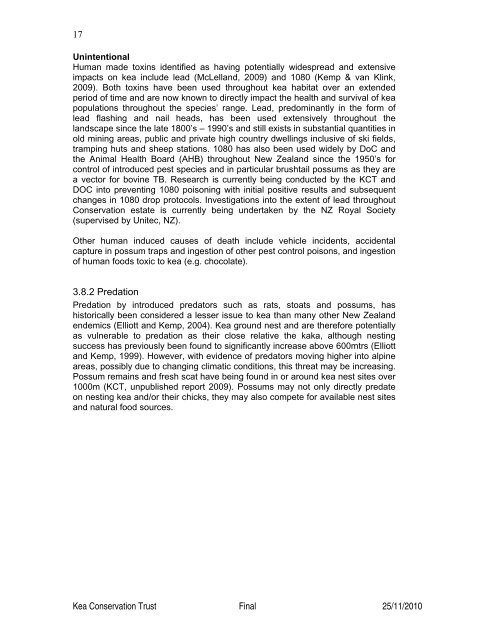(Nestor notabilis) Husbandry Manual - Kea Conservation Trust
(Nestor notabilis) Husbandry Manual - Kea Conservation Trust
(Nestor notabilis) Husbandry Manual - Kea Conservation Trust
You also want an ePaper? Increase the reach of your titles
YUMPU automatically turns print PDFs into web optimized ePapers that Google loves.
17<br />
Unintentional<br />
Human made toxins identified as having potentially widespread and extensive<br />
impacts on kea include lead (McLelland, 2009) and 1080 (Kemp & van Klink,<br />
2009). Both toxins have been used throughout kea habitat over an extended<br />
period of time and are now known to directly impact the health and survival of kea<br />
populations throughout the species’ range. Lead, predominantly in the form of<br />
lead flashing and nail heads, has been used extensively throughout the<br />
landscape since the late 1800’s – 1990’s and still exists in substantial quantities in<br />
old mining areas, public and private high country dwellings inclusive of ski fields,<br />
tramping huts and sheep stations. 1080 has also been used widely by DoC and<br />
the Animal Health Board (AHB) throughout New Zealand since the 1950’s for<br />
control of introduced pest species and in particular brushtail possums as they are<br />
a vector for bovine TB. Research is currently being conducted by the KCT and<br />
DOC into preventing 1080 poisoning with initial positive results and subsequent<br />
changes in 1080 drop protocols. Investigations into the extent of lead throughout<br />
<strong>Conservation</strong> estate is currently being undertaken by the NZ Royal Society<br />
(supervised by Unitec, NZ).<br />
Other human induced causes of death include vehicle incidents, accidental<br />
capture in possum traps and ingestion of other pest control poisons, and ingestion<br />
of human foods toxic to kea (e.g. chocolate).<br />
3.8.2 Predation<br />
Predation by introduced predators such as rats, stoats and possums, has<br />
historically been considered a lesser issue to kea than many other New Zealand<br />
endemics (Elliott and Kemp, 2004). <strong>Kea</strong> ground nest and are therefore potentially<br />
as vulnerable to predation as their close relative the kaka, although nesting<br />
success has previously been found to significantly increase above 600mtrs (Elliott<br />
and Kemp, 1999). However, with evidence of predators moving higher into alpine<br />
areas, possibly due to changing climatic conditions, this threat may be increasing.<br />
Possum remains and fresh scat have being found in or around kea nest sites over<br />
1000m (KCT, unpublished report 2009). Possums may not only directly predate<br />
on nesting kea and/or their chicks, they may also compete for available nest sites<br />
and natural food sources.<br />
<strong>Kea</strong> <strong>Conservation</strong> <strong>Trust</strong> Final 25/11/2010












